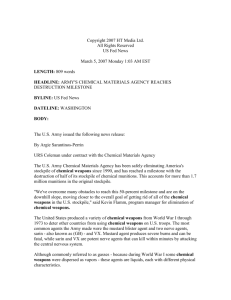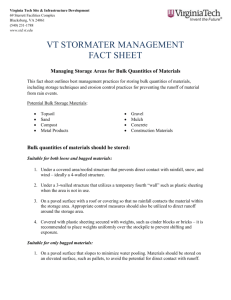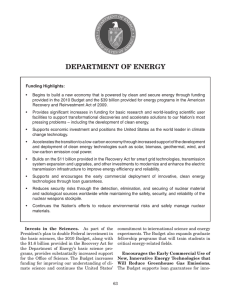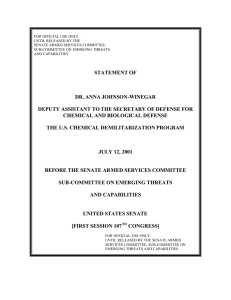STOCKPILE STEWARDSHIP AND A COMPREHENSIVE TEST BAN U.S. Senate October 7, 1999
advertisement
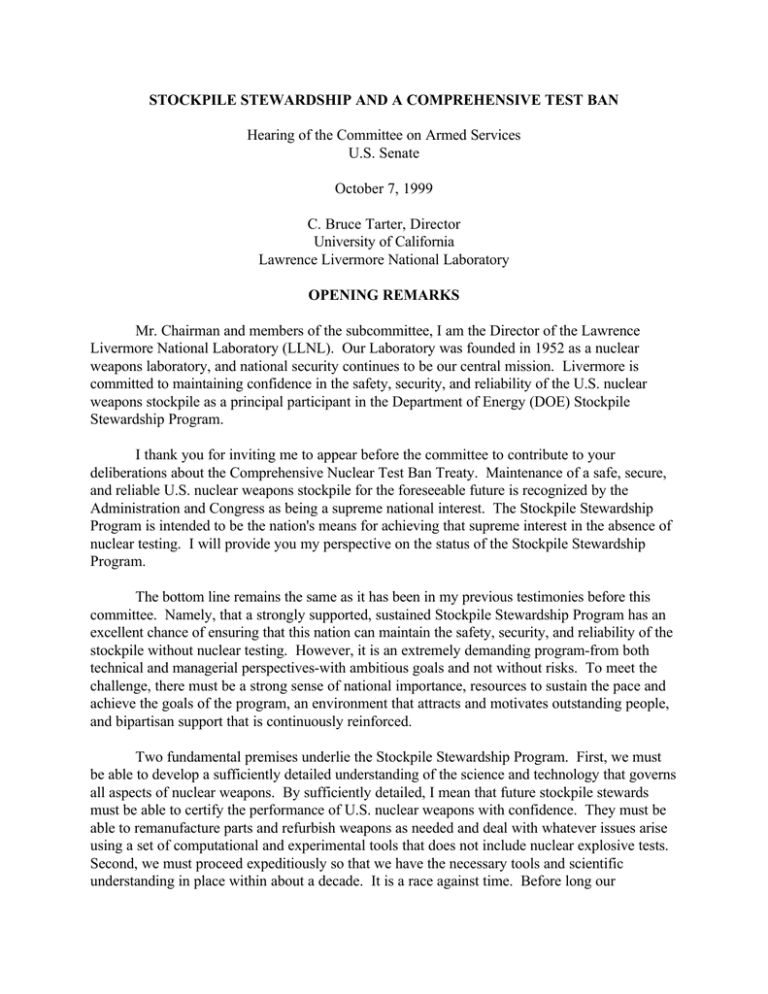
STOCKPILE STEWARDSHIP AND A COMPREHENSIVE TEST BAN Hearing of the Committee on Armed Services U.S. Senate October 7, 1999 C. Bruce Tarter, Director University of California Lawrence Livermore National Laboratory OPENING REMARKS Mr. Chairman and members of the subcommittee, I am the Director of the Lawrence Livermore National Laboratory (LLNL). Our Laboratory was founded in 1952 as a nuclear weapons laboratory, and national security continues to be our central mission. Livermore is committed to maintaining confidence in the safety, security, and reliability of the U.S. nuclear weapons stockpile as a principal participant in the Department of Energy (DOE) Stockpile Stewardship Program. I thank you for inviting me to appear before the committee to contribute to your deliberations about the Comprehensive Nuclear Test Ban Treaty. Maintenance of a safe, secure, and reliable U.S. nuclear weapons stockpile for the foreseeable future is recognized by the Administration and Congress as being a supreme national interest. The Stockpile Stewardship Program is intended to be the nation's means for achieving that supreme interest in the absence of nuclear testing. I will provide you my perspective on the status of the Stockpile Stewardship Program. The bottom line remains the same as it has been in my previous testimonies before this committee. Namely, that a strongly supported, sustained Stockpile Stewardship Program has an excellent chance of ensuring that this nation can maintain the safety, security, and reliability of the stockpile without nuclear testing. However, it is an extremely demanding program-from both technical and managerial perspectives-with ambitious goals and not without risks. To meet the challenge, there must be a strong sense of national importance, resources to sustain the pace and achieve the goals of the program, an environment that attracts and motivates outstanding people, and bipartisan support that is continuously reinforced. Two fundamental premises underlie the Stockpile Stewardship Program. First, we must be able to develop a sufficiently detailed understanding of the science and technology that governs all aspects of nuclear weapons. By sufficiently detailed, I mean that future stockpile stewards must be able to certify the performance of U.S. nuclear weapons with confidence. They must be able to remanufacture parts and refurbish weapons as needed and deal with whatever issues arise using a set of computational and experimental tools that does not include nuclear explosive tests. Second, we must proceed expeditiously so that we have the necessary tools and scientific understanding in place within about a decade. It is a race against time. Before long our nuclear-test veterans will be gone. We are counting on our current cadre of experienced scientists to help develop and install the new tools that only now are starting to come on-line. Those with experience must continue to work with their successors_both training them and evaluating their skills. The nation will be relying on these future stockpile stewards. Their judgments and decisions must be credible to others in the nuclear weapons community and to future Administrations and Congresses. From a technical perspective, we are satisfied with the progress we are making in many critical areas. The technical challenges are very demanding, and we are responding with the scientific and technical excellence that the nation expects from its DOE national security laboratories. Most importantly, we are developing greater confidence that our first premise is correct_with sufficient resources, sustained support, and top-notch people we should be able to develop the required tools and necessary understanding of the underlying science. Subsequently, I will provide examples of technical progress and key successes. On balance, we remain positive about the overall program's prospects for success. It is not a sure thing. We embarked on the Stockpile Stewardship Program knowing there were major challenges to overcome. The most difficult challenges lie in the future as the stockpile continues to age. But the future also promises much more sophisticated technical capabilities, which will be used to both resolve stockpile issues and test the competence of the stockpile stewards. Ultimately, success depends on achieving time-sequenced program goals on each and every front-some much more challenging than others. The most challenging technical issues, investments to meet beefed-up security requirements, and the greater than initially anticipated level of direct stockpile support needed to meet Department of Defense requirements are putting extra demands on program resources and affecting the rate of progress. The pace of progress must be quickened. Much remains to be accomplished, and the clock is running. In any discussion of stockpile stewardship, I stress one fundamental point. The program is no more and no less than the people that comprise it. I can guarantee that we will not be able to maintain the stockpile_with or without nuclear tests_without the hard work of an outstanding, dedicated staff. Unfortunately, events over the last year have increased the difficulty of recruiting and retaining top-notch talent. Our nuclear deterrent is a supreme national interest, and so is the program that maintains it, especially the people that are the program. I hope that your deliberations will bring attention to this connection. It would be especially helpful for the Administration and Congress to reaffirm the central role of a nuclear deterrent in U.S. national security strategy and the importance of the people committed to maintaining and operating those forces. STOCKPILE STEWARDSHIP PROGRAM PROGRESS AND ISSUES CTBT Safeguards and the Stockpile Stewardship Program In 1995, the President reached two critical decisions that set the course for nuclearweapons activities in the United States for the last four years. First, the President announced on August 11, 1995, that the U.S. would pursue a Comprehensive Nuclear Test Ban Treaty (CTBT) with no permitted nuclear weapon test explosions. In making that decision, he reaffirmed the importance of maintaining a safe and reliable nuclear weapons stockpile. Recognizing the possibility that stockpile stewardship without nuclear testing could fall short of its objectives, the President also established six specific safeguards that define the conditions under which the U.S. can enter into a CTBT. These safeguards are essential. Safeguards A and B condition U.S. entrance into a CTBT on "the conduct of a Science Based Stockpile Stewardship program to insure a high level on confidence in the safety and reliability of nuclear weapons..." and on "the maintenance of modem nuclear laboratory facilities and programs in theoretical and exploratory nuclear technology which will attract, retain, and ensure the continued application of our human resources to those programs..." These two safeguards pertain to the President's second critical decision, which was made on September 25, 1995. He directed the DOE to undertake the necessary programmatic activities to ensure continued stockpile performance. The Stockpile Stewardship Program formally began when the Record of Decision for the Programmatic Environmental Impact Statement, which defines the architecture of the program, was issued in December 1996. The Stockpile Stewardship Program has been designed to ensure the safety and reliability of the U.S. stockpile in an era of no nuclear testing, no new weapon development, a production complex with reduced capacity and capability, and an aging stockpile of fewer weapons and fewer types of weapons. Short of a return to a robust schedule of nuclear testing, it is a program that the nation needs to pursue vigorously. To date, it has received broad Congressional support. One other safeguard is particularly relevant to today's discussion_Safeguard F. Under a CTBT, Safeguard F would provide important protection against failure of the Stockpile Stewardship Program to achieve its goals. If a high level of confidence in the safety or reliability of a nuclear weapon type deemed to be critical to our nuclear deterrent could no longer be certified, the President, in consultation with Congress, could withdraw from the CTBT in order to conduct whatever testing might be required. We strongly support this safeguard and the development of a framework to ensure its successful implementation if it is needed. There are too many aspects of the Stockpile Stewardship Program for me to provide a detailed summary of the current status here. Rather, I shall focus on a set of key areas to give a top-level perspective of the program, provide a synopsis of progress to date, and highlight issues that affect the prospects of program success. Integrated Program Planning Integrated program planning, management, and execution is critical to the success of the Stockpile Stewardship Program. The three major program elements_surveillance, assessment, and refurbishment_are tightly interconnected, as are the activities of the three laboratories, the production plants, and the Nevada Test Site. Under the leadership of the Assistant Secretary of Energy for Defense Programs, integrated planning has been a great strength of the program and an important contributing factor to the significant technical progress that has been achieved. A detailed implementation plan has been developed that specifies roles and responsibilities within the program and defines the capabilities needed for stockpile stewardship without nuclear testing. As a living document, the implementation plan is updated and improved on an annual basis. This year, very significant improvements have been made in the plans for the Stockpile Stewardship Program's research and development activities. We have added plans for the final piece of the program_advanced radiography and hydrodynamic testing. We have also recast the ongoing research efforts into a set of activities that make program integration more evident, establish more clearly program goals and budget priorities, and help to identify program risks where there are budget shortfalls. An important feature of the restructured plans is a set of campaigns, each designed to achieve in 2005 a quantifiable end-state associated with a specific stockpile stewardship goal. As they progress toward their end states, the campaigns are to achieve scheduled interim objectives relevant to stockpile needs. A well-organized but less detailed plan also exists to refurbish and extend the life of the stockpile_the Life Extension Program (LEP). The plan integrates surveillance, assessment, and life-extension manufacturing activities for each weapon system, and (to the extent possible) it time-phases all activities to balance the workload. It is updated and improved as the laboratories and plants continue to refine comprehensive life-extension plans for each weapon system in the enduring stockpile. However, some aspects of the plan will remain preliminary until we develop a clearer understanding of the lifetime of individual components in weapon systems. The existing plan specifies significantly higher levels of stockpile refurbishment activity in the near term than anticipated at program inception in 1996. The Health of the Stockpile and Stockpile Certification In a formal sense, the Stockpile Stewardship Program is about three years old. As noted, the Record of Decision for the Programmatic Environmental Impact Statement was issued in December 1996. In practical terms, stockpile stewardship in the absence of nuclear testing has been under way much longer. We have maintained the nuclear weapons stockpile without nuclear testing since 1992, when the U.S. entered into a nuclear test moratorium. It has been over a decade since the newest nuclear weapon system entered into the stockpile. Formal review processes for certification of weapon safety and reliability in the absence of nuclear testing have been established as part of the Stockpile Stewardship Program. It is essential that judgments and decisions made by the stockpile stewards are credible among themselves, to the Department of Defense (DoD) and others in the nuclear weapons community, and to the Administration and Congress. In December 1998, we completed the third annual certification of the stockpile for the President and were able to conclude that nuclear tests were not required at that time to assure the safety and reliability of the nation's nuclear weapons. Annual certification is based on technical evaluations made by the laboratories and on advice from the three laboratory Directors, the Commander in Chief of the Strategic Command (CINCSTRAT), and the Nuclear Weapons Council. To prepare for annual certification, our laboratory collects and analyzes all available information about each stockpile weapon system, including physics, engineering, chemistry, and materials science data. This work is subjected to rigorous, in-depth review by managers and scientists throughout the program. Three important factors have enabled us to meet the challenge to date of certifying stockpile safety and performance in the absence of nuclear testing. First, the weapons intended for the enduring stockpile all have good pedigrees_they went into the stockpile with thorough and well-documented test histories. To date, we have seen no signs of catastrophic aging. However, it is the case that the stockpile is proving to need more "care and feeding" than anticipated when the Stockpile Stewardship Program began. The schedule for LEPs is more aggressive than originally planned, and each LEP to date is requiring more extensive refurbishment and effort than originally anticipated. Even greater vigilance will be required as the stockpile continues to grow older because nuclear weapons age in very dynamic but not necessarily predictable ways. Both the difficult task of assessing an ever older stockpile and the new challenge of certifying refurbished weapons increase the complexity of stockpile stewardship as time passes. Second, we have been able to meet the challenge because of the expertise residing in the technical staff_hands-on nuclear design, engineering, and test experience accumulated through the development of weapons now in the stockpile. But that experience base is also aging, so we are taking important steps to archive that experience and make prudent use of it while we have it. That includes working with the next generation of scientists and engineers to tend to the current needs of the stockpile and lay the foundation for the long-term program for stockpile stewardship. Third, as discussed above, we have worked closely with DOE Defense Programs to design and implement an overall Stockpile Stewardship Program that is delivering increasingly capable tools for weapon surveillance, assessment, and refurbishment. Assessments and certification of the performance of stockpiled weapons and modification actions must be demonstration-based_that is, grounded on existing nuclear test data, component-level experiments and demonstration, and simulations using detailed, validated computer models. We are engaged in a balanced and integrated program of computational simulation, fundamental scientific research, and experiments. Steady technical progress on a number of fronts moves us closer to the program's long-term goals. Technical Progress There are good reasons to be technically optimistic about the prospects for success with the Stockpile Stewardship Program. In terms of accomplishments, the program is progressing well in many key technical areas. We continue to make considerable headway in developing a basis for understanding aging effects in weapon materials. We are effectively using our existing experimental tools and our greatly expanded computational capabilities to address current stockpile issues through the development of a much improved fundamental understanding of weapon performance. In addition, the first program to extend the stockpile life of a weapon system is on schedule. The first unit of the refurbished W87 ICBM warhead was completed in February 1999. The first significant modification of a weapon, the B61-11 bomb, has also already entered into the stockpile. Two areas merit particular attention. First, the Accelerated Strategic Computing Initiative (ASCI) has made outstanding progress. In January 1999, Livermore took delivery ahead of schedule of the 3.9-teraops IBM Blue Pacific supercomputer. This new machine and the one delivered to Los Alamos this year are the fastest and most capable supercomputers in the world. We are using the machines for stockpile stewardship applications in complex computational simulations that run on thousands of processors. In addition, advanced visualization theaters are able to display vast amounts of data in ways that provide new insights into the calculations. Program plans call for an increase to 10teraops performance in 2001 and much greater capability in 2004. ASCI machines at Livermore have performed very detailed calculations of 3-D phenomena that were long suspected of having a major influence on weapon performance and that simply could not be addressed prior to the ASCI program. These computers have also supported the W76 warhead dual revalidation effort and the program to extend the lifetime of the W87. In addition, we have also used advanced simulation codes and the enhanced computing power to study high-explosives safety issues, evaluate requirements for inertial confinement fusion capsule manufacture, and greatly improve our understanding of the properties of plutonium and other materials. Second, we have made tremendous advances in the development of fast, high-resolution instrumentation and diagnostics and associated experimental techniques. The advances enable us to obtain crucial information about the properties of plutonium from experiments at the Nevada Test Site. They open up possibilities for weapon science experiments using the National Ignition Facility that were not even contemplated a few years ago. In addition, they make it possible for us to gather more revealing data from hydrodynamic tests. In particular, upgrades to Livermore's Flash X-Ray Facility and the development of a gamma-ray camera have dramatically improved our ability to conduct "core punch" experiments. In these experiments, scientists use high-energy radiography to record a digital image of the detailed shape of the gas cavity inside the pit when it is highly compressed. Last year, the first core punches were carried out for two important stockpile primary devices: the W76 SLBM warhead (a Los Alamos design) and the B83 strategic bomb. Progress in some areas, however, has been slower than anticipated. Working with plutonium for the subcritical experiments and for the enhanced surveillance program has proven to be very difficult. Livermore conducted its third and fourth subcritical experiments at the Nevada Test Site during FY1999. Designed to study the behavior of plutonium when it is shocked and accelerated by high explosives, our experiments have been very successful, but they are being performed at a slower rate than originally planned. Important experimental facilities, such as the Dual Axis Radiographic Hydrodynamic Test Facility (DARHT), the National Ignition Facility (NIF), the gas-gun at the Nevada Test Site, and Atlas, are technically sound programs but are somewhat behind schedule and are now projected to cost more than anticipated. Timely construction of these facilities is essential for stockpile stewardship to succeed. For the NIF, in particular, we are working with DOE to establish a path forward which focuses on meeting programmatic milestones with minimum costs and schedule impacts on the overall program. When completed, DARHT and NIF will be used to conduct integral experiments of nuclear-weapons-relevant physics. These experiments will test and validate the physics and engineering models in simulation codes that are being developed on the most advanced ASCI supercomputers. The Race Against Time For stockpile stewardship to succeed, we must move ahead with the program as rapidly and completely as possible. It is a race against time. Inside the next decade, many of our nuclear-test veterans will be gone. We are counting on our current cadre of experienced scientists to help develop and install the new tools only now starting to come on-line. The experienced hands are working with their successors_both training them and evaluating their skills. Activities such as dual revalidation, weapon-physics code development, and life-extension programs are both crucial to immediate stockpile needs and an opportunity for training. Evaluations of these mentoring efforts are an integral part of the program's self assessment of the people and their capabilities in implementing the program. Time is also important because the demands on the Stockpile Stewardship Program will continue to grow as weapons continue to age. The U.S. nuclear weapons stockpile is older on average than it has ever been. The greatest challenges lie ahead. And, ultimately, success depends on achieving time-sequenced program goals on each and every front-some much more challenging than others. For these reasons, we cannot allow the program to stretch out significantly longer than a decade. A number of challenging technical issues, investments to meet beefed-up security requirements, and the greater than initially anticipated level of direct support required for the stockpile are putting extra demands on program resources and affecting the rate of progress. It is also the case that we have received less funding than requested each year since the program's inception. The pace of progress needs to be quickened. Much remains to be accomplished, and the clock is running. Program Personnel The Laboratory's successes in contributing to stockpile stewardship are due to the efforts of an outstanding, dedicated technical staff at Livermore. Similar contributions are being made by researchers at Los Alamos and Sandia national laboratories and by personnel at the Nevada Test Site and DOE's production facilities. Demanding responsibilities require top-notch people and their expert judgment. We rely on having highly qualified and experienced people that are motivated by the opportunity to do something important for the country, technical challenges in their careers, and access to the tools needed to get the job done. We face the absolutely crucial challenge of maintaining expert judgment about nuclear weapons issues. That challenge has been recognized from the onset of the Stockpile Stewardship Program by this committee and those of us engaged in the program, and it has been very carefully considered by the Commission on Maintaining United States Nuclear Weapons Expertise (the "Chiles Commission"). The Commission did an excellent job of consolidating workforce information across the DOE laboratory and production complex. They have correctly pointed out the need for a sustained recruiting and training effort at the laboratories to supplement our veteran workforce. In 1998, we took steps to increase and improve our recruiting efforts. More importantly, for prospective employees (and for retention of experienced stockpile stewards having other work opportunities) there was the prospect of exciting technical challenges, program stability, and service to the country. We were optimistic that we would be able to attract and retain the talent the nation needs to maintain stockpile safety and reliability in the early 2 1 st century. However, events over the last year are making it more difficult to recruit and retain top-notch talent. Regardless of the specifics of the issues, news headlines about spying, mismanagement, potential management changes (within DOE or affecting the Laboratory's long-standing tie to the University of California), polygraph testing, and greater restrictions on unclassified scientific interchanges are significant obstacles we have to overcome. Likewise, the reductions in Laboratory-Directed Research and Development (LDRD) funding will significantly hinder our efforts to attract and retain talented staff, who are challenged by the opportunities LDRD offers to make breakthrough advances in science and technology in support of our mission. Within the constraints of the FY 2000 budget, other factors such as potentially unfunded mandates for computer security upgrades may also decrease our flexibility to bring new talent into the program. After such a disruptive year, we must regain momentum. The program's future prospects would greatly benefit from a strong reaffirmation by national leaders that they highly value the efforts of the stockpile stewards and that they are fully committed to providing the resources and cutting-edge research opportunities needed to "attract, retain, and ensure the continued application of our human resources" to stockpile stewardship, as specified by Safeguard B. CONCLUDING REMARKS Your deliberations about the Comprehensive Nuclear Test Ban Treaty (CTBT) must take into account and weigh many factors. One fixed point in the discussion is the need for the U.S. to maintain a safe, secure, and reliable nuclear weapons stockpile for the foreseeable future. That is a supreme national interest. Short of a return to a robust schedule of nuclear testing, the nation must continue to rely on the DOE's Stockpile Stewardship Program to maintain the U.S. nuclear deterrent, identify issues with an aging stockpile, and remanufacture parts and refurbish nuclear weapons as necessary. At Livermore, we are fully committed to meeting the Stockpile Stewardship Program's ambitious goals. I have tried to summarize our successes and the challenges we face so that you better understand the risks involved. On balance, we remain positive about the prospects for success. We are satisfied with the progress in many critical areas. Stockpile stewardship is very demanding, and we are responding with the scientific and technical excellence that the nation expects from its DOE national security laboratories. With sustained support and a clear sense of national purpose we should be able to meet our commitments to this challenging task.
